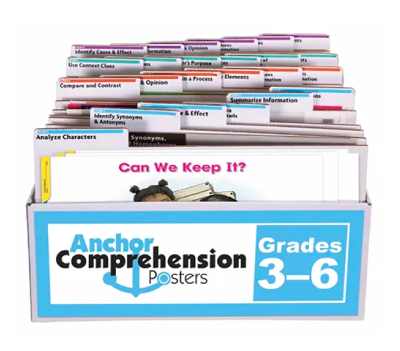- Benchmark Education
- Newmark Learning
- Reycraft Books
- Create an Account
Best Practices in Reading Comprehension: 6 Strategies to Teach Students

Learning how to read may be a challenging endeavor that can frustrate even the most determined students. While decoding words on a page is one thing, comprehending what is being read is something else entirely. This difficulty can exist for accelerated readers, striving readers, and everyone in between.
To help students build both reading fluency and comprehension skills, various strategies should be used. Research shows that using a combination of techniques to improve reading comprehension is ideal.
There are six main types of comprehension strategies available for use in the classroom, and each provides its own unique set of benefits for various types of learners. While the ultimate goal of teaching children to read is to help them attain comprehension skills, the building blocks for doing so are recognition, decoding, and fluency. Without these building blocks in place, students cannot comprehend what they read. They require comprehension to acquire knowledge or express their ideas, whether through written or spoken words. Reading comprehension strategies aid students in attaining those crucial building blocks and, ultimately, comprehension.
When Is Comprehension Evident?
It’s important to recognize signs of students who have acquired comprehension skills. Readers who understand what they read are able to:
-
Interpret and evaluate events, ideas, dialogue, and information
-
Connect information to ideas they already have and facts they already know
-
Adjust their knowledge to include new ideas
-
Reframe their knowledge to look at their ideas from a different perspective
-
Determine the most essential details of a passage
-
Understand and describe underlying meanings
When students comprehend what they read, they can predict, infer, and seek answers to questions that arise. A reader who comprehends should be able to recognize deeper meanings as they review and re-read portions of text.
Types of Comprehension Strategies
There are six types of strategies to improve reading comprehension:
-
Making connections
-
Asking questions
-
Visualizing events
-
Determining text importance
-
Making inferences
-
Synthesizing information to make new thoughts
While three of these strategies (making connections, asking questions, and visualizing) are typically easy for learners to grasp, the others are often more challenging.
1. Making Connections
When readers can connect the topic or certain information to what they already know about themselves or the world, they relate to the text.
2. Asking Questions
Asking questions and searching for the answers is an effective reading comprehension strategy. Readers can ask questions about what they have read, assess their own reactions, and infer the author’s reason for writing the text.
3. Visualizing
Being able to visualize or imagine events from a text in their minds is very helpful for students. When they can visualize what is happening, it makes the printed word more “real” and easier to comprehend and remember.
4. Determining Text Importance
It can be difficult for readers to separate what is important to the story vs. what is interesting to them. They must learn to distinguish between fact and opinion, recognize cause-and-effect relationships, and compare ideas and information.
In addition, readers must learn to pinpoint conflicts, problems, and solutions, identify steps involved in processes, locate information or answers to questions, and summarize what they have read.
5. Making Inferences
When readers can make inferences, they merge clues within what they have read with prior knowledge they’ve attained. They will be able to answer questions that lead to conclusions regarding underlying themes and ideas.
6. Synthesizing
When readers can take new information from texts and combine it with their existing knowledge, they can hone their skills in reading comprehension. Using newly attained information as a launchpad or springboard to form their own original ideas can expand to new lines of thinking and new creations.
How to Teach Reading Comprehension Strategies to Students
The most effective way to teach these six strategies to sharpen comprehension skills is by modeling during think-alouds. When teachers think out loud, they are showing students what skilled readers do.
The Case for Think-Alouds
Think-alouds serve many purposes and offer many advantages. Conducting think-alouds is a way to create a record of the decision-making process, report everything the reader notices, feels, and understands, and talk about the strategies being used with the content being read.
To conduct think-alouds in the classroom, the teacher can:
-
Model the think-aloud while reading aloud as students listen
-
Think out loud during shared reading and ask students to help
-
Have students think out loud during shared reading while others help
-
Have students think out loud while writing in journals
-
Have students think out loud individually while writing in journals and then compare notes with other students
Think-alouds are excellent tools to use during shared reading times and read-alouds. They are also ideal to use during small-group reading times.
Prepare Ahead of Time
Choose a short text or section of text and read it ahead of time. Mark the spots where you will model your chosen strategy. Make sure to name the strategy for students and explain the focus of your think-alouds. Read through the text, stopping at marked points and thinking out loud. Reinforce your think-alouds with follow-up lessons.
Helpful Language Prompts to Use When Modeling with Think-Alouds
For each of the six comprehension strategies, there are helpful language prompts teachers can use to model strategies during think-alouds:
Making Connections
Some language prompts teachers can use to make connections include:
-
This reminds me of a time when…
-
I know about this topic because…
-
The setting of this text is just like…
Another prompt might be: What’s happening in this book is just like what happened in…
Asking Questions
Prompts that can be used to encourage thought-provoking questions might be:
-
While I’m reading, I’m trying to figure out…
-
I wonder why…
-
Why did (a certain character) do that?
-
What will happen next?
Teachers might also ask for students’ help—for instance, explaining that something doesn’t make sense and stating that they need to re-read it to find an answer.
Visualizing
Prompts to help visualization can include:
-
When the author describes (this), I picture…
-
I can draw a picture of what is being described
-
I can really see what the author is talking about when they…
A final prompt could be: I really can imagine myself in (the setting)...
Determining Text Importance
Prompts to help determine text importance might be:
-
There is lots of information here, and I need to decide what is important
-
Let me take the big ideas and summarize
-
I know these details are important because they match my purpose for reading, which was to…
Teachers might also describe what they believe the author thinks is important and why.
Making Inferences
Prompts for inferring details might be:
-
The clues tell me that (this) is what’s really going on
-
I think (something) will happen next because the author said…
-
The author says this but means…
Using clues and “reading between the lines” is key when making inferences.
Synthesizing
Useful prompts for teachers for encouraging synthesizing during think-alouds can include:
-
My opinion of (this) is…
-
I first thought (this) about (this), but now, I think…
-
The story is about (this), and my views on it are…
Teachers can also invite students to share their own opinions and thoughts.
What Next?
Join Deborah Glaser, Ed.D. for an on-demand PD webinar, Reading Fluency: The Ultimate Goal of Reading Instruction. This webinar explores what it means to read fluently, and how this goal of reading impacts our instruction. Attendees will take away renewed understanding of their students’ reading fluency and many practice activity ideas that can be easily implemented right away in small-group intervention and during whole-group instruction.
Watch Now →
You May Like: Anchor Comprehenshion Workshop













Comments